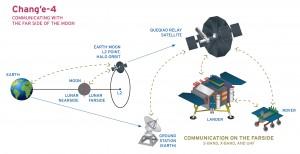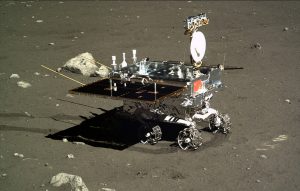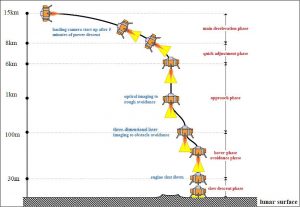As we know, China has achieved the first successful soft landing on the far side of the moon with the spacecraft which is named Chang’e 4. This is a huge achievement because it is the first time that humans have been able to see or investigate the back side of the moon. Due to the interaction of forces between the Earth and the Moon, the revolution and cycles of the Moon are always the same as those of the Earth, which means that we can only forever see the same side of the moon from the Earth, which causes the phenomenon called ‘tidal lock.’ In order to uncover the the mysterious back of the moon and help humans know more about it, Chang’e 4 has landed there and carried out the mission.

https://commons.wikimedia.org/wiki/File:20180912_6258TPS-TPR-2018Q3-18-09-04-p14legacy.png
Landing Process
The landing of chang’e 4 is divided into 4 parts. First of all, power reduction process starts at 15KM above the moon ground and the speed of the spacecraft decreases from 1.7km/s to 0. Then, at about 6-8KM, the detector performs a quick attitude adjustment. When the detector reaches 100m above the ground, it stops and tries to identify obstacles and slopes.
Difficulty of landing on the back side
The soft landing on the far side of the moon is really difficult because there are many craters on the back of the moon, especially in the Antarctic-Aitken Basin, and the terrain of elevation is extremely complex. What’s more, in the process of the landing, the direction of the Earth is unavailable. All the information needs to be transferred by the Trunk star and there is delay on the image transfer, which means the whole process of landing is blind.

https://www.flickr.com/photos/lunarpioneer/1250053951 Joel Raupe
Significance of soft landing
This landing matters a lot to the science world. For astronomers, the back of the moon is a quiet and good place to conduct radio observations. Because the celestial bodies in the universe are very far away from us, the electromagnetic signal is very weak. Therefore, astronomers hope to build telescopes in completely quiet areas to monitor weak electromagnetic signals from the universe. On the back of the moon, the moon itself blocks various interfering signals from the Earth, so it can detect electromagnetic signals that are indistinguishable on Earth.
Fan Feng

